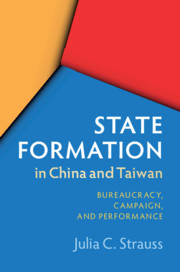Book contents
- State Formation in China and Taiwan
- State Formation in China and Taiwan
- Copyright page
- Dedication
- Contents
- Figures
- Acknowledgments
- Introduction
- 1 Virtue and Talent in Making Chinese States
- 2 Comparative Terror in Regime Consolidation
- 3 Performing Terror
- 4 Repertoires of Land Reform Campaigns in Sunan and Taiwan, 1950–1954
- 5 Theaters of Land Reform
- Conclusion
- Book part
- Documentary Collections, Reports, and Periodicals
- Bibliography
- Index
5 - Theaters of Land Reform
Bureaucracy, Campaign, and the Show, 1950–1954
Published online by Cambridge University Press: 13 October 2019
- State Formation in China and Taiwan
- State Formation in China and Taiwan
- Copyright page
- Dedication
- Contents
- Figures
- Acknowledgments
- Introduction
- 1 Virtue and Talent in Making Chinese States
- 2 Comparative Terror in Regime Consolidation
- 3 Performing Terror
- 4 Repertoires of Land Reform Campaigns in Sunan and Taiwan, 1950–1954
- 5 Theaters of Land Reform
- Conclusion
- Book part
- Documentary Collections, Reports, and Periodicals
- Bibliography
- Index
Summary
In Sunan and Taiwan land reform was implementd by campaign, and in both the early to middle stages of the campaign were remarkably similar. Both conducted training, temporarily expanded the state bureaucracy with young recruits, and engaged in massive propaganda to convince the public of the desirability and necessity of land reform. Both also desired active rural participation in land reform. The ways in which land reform was publicly performed and rural participation invited in were very different: in Sunan participation was a mass public event that vilified targets and concluded with the merging of state and crowd while in Taiwan public participation was solicited through the procedural drama of limited public elections to Farm Tenancy Committees.
Keywords
- Type
- Chapter
- Information
- State Formation in China and TaiwanBureaucracy, Campaign, and Performance, pp. 205 - 242Publisher: Cambridge University PressPrint publication year: 2019

